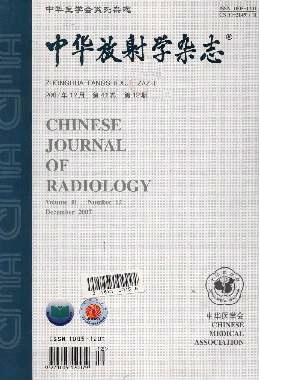The CT imaging features of hepatoblastoma in term neonates
Q4 Medicine
Zhonghua fang she xue za zhi Chinese journal of radiology
Pub Date : 2020-02-10
DOI:10.3760/CMA.J.ISSN.1005-1201.2020.02.011
引用次数: 0
Abstract
Objective To investigate the CT features of hepatoblastoma in term neonates. Methods The clinical data and abdominal CT features of 7 children with neonatal hepatoblastoma confirmed by surgical pathology from January 2015 to January 2019 in Hunan Children′s Hospital were retrospectively analyzed, focusing on the position, size, shape, density and dynamic enhancement characteristics of the mass. Results All 7 cases were solitary intrahepatic mass, which affected the liver SⅥ in 2 cases, SⅦ in 2 cases, SⅤ+Ⅵ in 1 case, SⅡ+Ⅲ in 1 case, SⅣa+Ⅴ+Ⅷ in 1 case. The maximum diameters were 2.9-10.2 cm (median maximum diameter 4.7 cm). Four cases tumors were spherical shape, while 3 cases were irregular lobulation and extended to the outside of live. The boundary was clear in 6 cases and fuzzy in 1 case. Necrosis, calcification, patchy hemorrhage was shown in 4 cases, 1 case, 5 cases, respectively. All 7 cases tumors showed heterogeneous enhancement, with multiple nodular and lamellar obvious enhancement at the center and edge of the tumor in arterial phase, and gradually filling-in, presented as multiple bands and island-like enhancement, with prominent edge enhanced but no enhancement in the necrotic area in portal venous and delayed phase. The tumor invaded portal vein and bile duct in hilar area in 1 case, with the intra-hepatic bile duct dilation. The caliber of the abdominal aorta below celiac trunk became thinner in 3 cases. 6 cases were epithelial fetal type and 1 case was mixed type with pathological confirmed. Conclusion The main CT manifestations of neonatal hepatoblastoma are spherical or lobulated, with varied degrees of necrotic, hemorrhage and calcification, and heterogeneous enhancement with gradually regional expansion. Key words: Neonates; Hepatoblastoma; Tomomography, X-ray computed; Alpha fetoprotein足月新生儿肝母细胞瘤的CT影像学特征
目的探讨足月新生儿肝母细胞瘤的CT表现。方法回顾性分析2015年1月至2019年1月湖南省儿童医院经手术病理证实的7例新生儿肝母细胞瘤患儿的临床资料及腹部CT表现,重点分析肿块的位置、大小、形态、密度及动态增强特征。结果7例都是孤独的肝内质量,影响肝脏的年代Ⅵ2情况下,SⅦ2例,Ⅴ+Ⅵ1例,1例Ⅱ+Ⅲ,年代Ⅳ+Ⅴ+Ⅷ1例。最大直径2.9 ~ 10.2 cm,中位最大直径4.7 cm。肿瘤呈球形4例,不规则分叶状3例,向活体外延伸。边界清晰6例,模糊1例。坏死4例,钙化1例,斑片状出血5例。7例肿瘤均呈非均匀强化,动脉期肿瘤中心及边缘多发结节及板层状明显强化,逐渐充盈,呈多条带及岛状强化,门静脉期及延迟期坏死区边缘强化明显,无强化。肿瘤侵袭门静脉及肝门区胆管1例,伴肝内胆管扩张。腹腔干下腹主动脉径变细3例。上皮胎儿型6例,病理证实混合型1例。结论新生儿肝母细胞瘤的CT主要表现为球形或分叶状,并伴有不同程度的坏死、出血和钙化,呈不均匀强化,局部逐渐扩大。关键词:新生儿;肝母细胞癌;层析成像,x线计算机;α胎蛋白
本文章由计算机程序翻译,如有差异,请以英文原文为准。
求助全文
约1分钟内获得全文
求助全文
来源期刊

Zhonghua fang she xue za zhi Chinese journal of radiology
Medicine-Radiology, Nuclear Medicine and Imaging
CiteScore
0.30
自引率
0.00%
发文量
10639
 求助内容:
求助内容: 应助结果提醒方式:
应助结果提醒方式:


